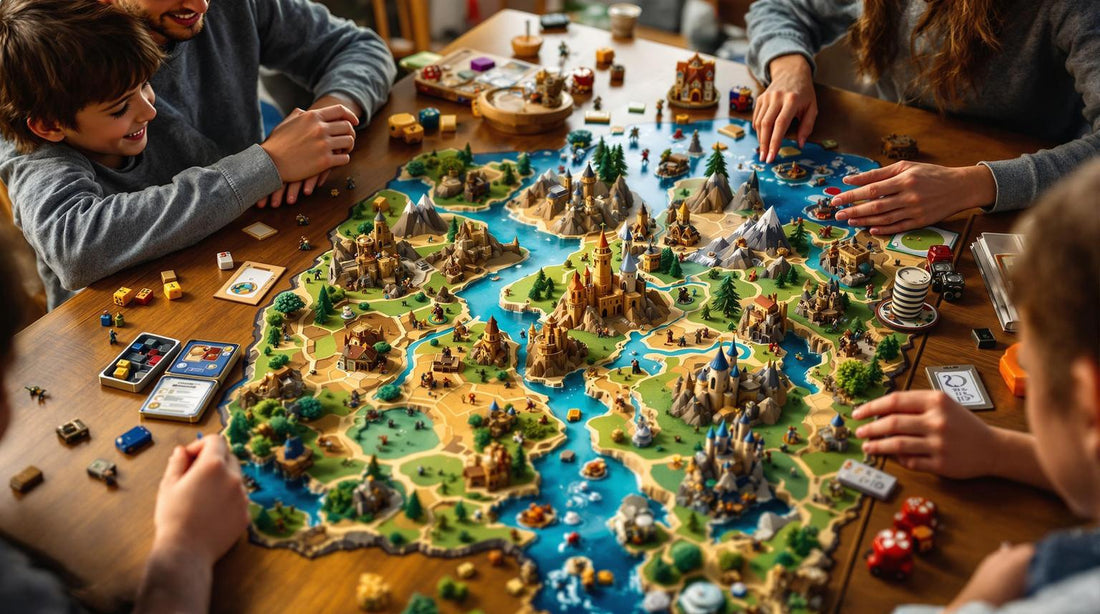Discover the Best Board Games for Every Player

How Map Exploration Games Improve Spatial Reasoning
Spatial reasoning is essential for tasks like navigation and problem-solving, and map exploration games are a fun way to strengthen these skills. Here's why they work:
- Boost Spatial Skills: Games like GeoGuessr and Minecraft improve map reading, distance estimation, and mental object rotation.
- Enhance Problem-Solving: Players develop strategic thinking by analyzing environments and planning routes.
- Improve Memory: Exploring virtual maps enhances spatial memory and hippocampal function.
- Accessible for All Ages: Both digital and physical map games cater to children, students, and adults.
Key Benefits in Numbers:
- 70% of students improved spatial test scores after training.
- Structured gameplay enhances memory and problem-solving abilities.
Whether digital or physical, map games are an engaging tool to sharpen spatial reasoning and cognitive skills.
Building Spatial Skills through Video Game Play
How Map Games Improve Thinking Skills
Improved Understanding of Space and Distance
Map-based games can change the way players grasp spatial relationships. These virtual environments help sharpen distance perception and orientation skills. Studies indicate that spending time with interactive maps enhances performance in tasks that require spatial understanding.
- Learn to judge relative distances between points
- Develop a better sense of object orientation in space
- Process detailed spatial data more effectively
For example, a study involving a virtual city demonstrated that using interactive maps improved players' ability to accurately determine house orientations. These skills create a strong foundation for tackling more advanced problem-solving tasks.
Enhanced Problem-Solving Abilities
Map games bring unique challenges that boost logical thinking and strategy. Take GeoGuessr, for instance - it encourages players to figure out their location using environmental hints by:
- Analyzing unfamiliar surroundings systematically
- Identifying patterns in landscapes and architecture for accurate guesses
- Planning routes efficiently, often under time constraints
These games go beyond navigation and contribute to broader cognitive growth.
Development of Mental Skills
A 2019 study on Minecraft highlighted how structured map exploration can improve hippocampal memory.
"Both spatial exploration and building were at least partly responsible for this observed improvement."
The research pointed to two main factors driving these cognitive gains:
- The degree of spatial exploration, measured by roaming entropy
- The complexity of structures created within the game
Players who took on directed building tasks showed better hippocampal function, reflected in higher lure discrimination index scores.
- Work on intricate construction projects that demand spatial planning
- Explore varied environments to increase roaming entropy
- Build complex designs that involve vertical navigation features
sbb-itb-1ed942f
Types of Map Games
Digital Map Games
Digital map games use technology to present fast-paced spatial challenges that require quick thinking and navigation. Research shows that frequent gamers, particularly university students, tend to have stronger spatial abilities and perform better when tackling spatial tasks.
Board Games with Maps
Physical map games, like board games, focus on hands-on interaction and social engagement. These games allow players to engage directly with physical maps, offering a tactile experience that's hard to replicate digitally. Cedar from For My Wonderful World highlights this unique aspect:
"Unlike video games, they give us an excuse to interact with actual, physical, tangible maps. Unlike atlases, they let us do things on the map, like navigating them with ships, cards, and figurines".
Popular map-based board games, such as those available at Brain Games, combine spatial reasoning with strategy. They encourage face-to-face interactions, physical manipulation of map components, and collaborative problem-solving. This makes them a great way to develop spatial awareness while enjoying a social activity.
Learning-Focused Map Games
Learning-focused map games are designed to improve spatial reasoning and geographic knowledge through structured tasks. For instance, "Map Adventure" combines navigation challenges with spatial exercises.
Studies suggest that training spatial skills can significantly increase the number of students reaching high levels of spatial ability, essential for fields like engineering. The National Council of Teachers of Mathematics now prioritizes spatial reasoning in early education, from pre-kindergarten through eighth grade. Garland Classical Academy provides a real-world example of success: using an AI-driven game-based app, they saw major improvements in students' math skills and spatial reasoning. This progress is credited to features like instant feedback, skill progression, and critical thinking tasks. When paired with hands-on activities, these games create a well-rounded approach to building spatial skills.
Getting the Most from Map Games
Map Games in Learning
Using map games in education can help improve spatial reasoning. According to National Geographic's 2014 research:
"Spatial thinking is arguably one of the most important ways of thinking for a child to develop as he or she grows... A student who has acquired robust spatial thinking skills is at an advantage in our increasingly global and technological society"
To strengthen these skills, use precise spatial vocabulary instead of vague terms like "here" or "there". Words like "northeast", "adjacent to", or "parallel with" help build a stronger sense of spatial awareness.
One example is The OT Toolbox's backyard mapping activity. It involves drawing detailed maps of the yard, hiding objects, and marking their locations with an "X." Adding a twist - like playing in low-light with headlamps - can further improve map-reading skills by encouraging reliance on spatial reasoning over visual scanning.
This approach naturally sets the stage for combining digital and physical formats to deepen spatial learning.
Mix of Digital and Physical Games
Blending digital and physical games provides a balanced way to enhance spatial skills. For example, Brain Games offers map-based board games for hands-on learning, while platforms like Seterra deliver interactive digital experiences.
| Game Format | Key Benefits | Practice Tip |
|---|---|---|
| Physical Games | Hands-on interaction, social engagement | Use during family time; try model building |
| Digital Games | Instant feedback, level progression | Practice 15–20 minutes daily; focus on regions |
| Hybrid Activities | Appeals to different learning preferences | Alternate formats for reinforcement |
No matter the format, consistent practice is essential to maximize spatial gains.
Building a Regular Practice
Spatial learning expert Ariana Zilliacus highlights the importance of consistency:
"The more you practice, the better you become, but consistency is key. That's why is so important that you have fun doing it"
Here are some effective ways to practice:
- Navigate familiar areas without GPS to boost mental mapping.
- Build models using construction kits or recyclable materials.
- Solve map puzzles daily to keep skills sharp.
Educators have observed that incorporating map games into regular routines leads to better geographic understanding. Consistent engagement not only strengthens spatial skills but also reinforces the cognitive benefits these games offer.
Conclusion
Main Findings
Studies reveal that map exploration games can improve spatial reasoning by activating several cognitive processes, including visual processing, mental navigation, spatial memory, and problem-solving. For instance, research suggests that widespread use of map-based spatial training could significantly improve spatial skills among U.S. students.
Here’s how these cognitive areas contribute:
| Cognitive Area | Impact on Spatial Skills |
|---|---|
| Visual Processing | Better understanding of spatial relationships |
| Mental Navigation | Enhanced ability to create and adjust mental maps |
| Spatial Memory | Improved recall of location-based information |
| Problem-Solving | Greater strategic thinking in spatial scenarios |
What's Next for Map Games
The advancements in map exploration games are opening up new possibilities for spatial learning. For example, Niantic's Visual Positioning System (VPS) delivers precise augmented reality experiences, offering learners a more immersive way to engage with spatial concepts. Similarly, tools like PRELOADED's Wonderlab AR blend spatial learning with real-world exploration.
Emerging technologies like AI and advanced location intelligence are shaping the future of these games. Urbanoid’s mixed-reality environments, for example, highlight how personalized learning tools can elevate spatial reasoning development.
These innovations are making spatial learning tools more engaging and accessible for people of all ages. As technology evolves, map games are set to become even more effective in building critical spatial skills.






